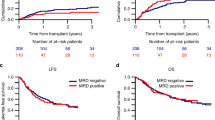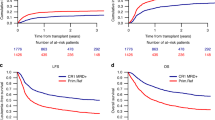Abstract
Minimal residual disease (MRD) is associated with adverse outcome in acute myeloid leukemia (AML) after myeloablative (MA) hematopoietic cell transplantation (HCT). We compared this association with that seen after nonmyeloablative (NMA) conditioning in 241 adults receiving NMA (n=86) or MA (n=155) HCT for AML in first remission with pre-HCT bone marrow aspirates assessed by flow cytometry. NMA patients were older and had more comorbidities and secondary leukemias. Three-year relapse estimates were 28% and 57% for MRDneg and MRDpos NMA patients, and 22% and 63% for MA patients. Three-year overall survival (OS) estimates were 48% and 41% for MRDneg and MRDpos NMA patients and 76% and 25% for MA patients. This similar OS after NMA conditioning was largely accounted for by higher non-relapse mortality (NRM) in MRDneg (30%) compared with MRDpos (10%) patients, whereas the reverse was found for MRDneg (7%) and MRDpos (23%) MA patients. A statistically significant difference between MA and NMA patients in the association of MRD with OS (P<0.001) and NRM (P=0.002) but not relapse (P=0.17) was confirmed. After adjustment, the risk of relapse was 4.51 times (P<0.001) higher for MRDpos patients. These data indicate that the negative impact of MRD on relapse risk is similar after NMA and MA conditioning.
This is a preview of subscription content, access via your institution
Access options
Subscribe to this journal
Receive 12 print issues and online access
$259.00 per year
only $21.58 per issue
Buy this article
- Purchase on Springer Link
- Instant access to full article PDF
Prices may be subject to local taxes which are calculated during checkout


Similar content being viewed by others
References
Hamilton BK, Copelan EA . Concise review: the role of hematopoietic stem cell transplantation in the treatment of acute myeloid leukemia. Stem Cells 2012; 30: 1581–1586.
Cornelissen JJ, Gratwohl A, Schlenk RF, Sierra J, Bornhäuser M, Juliusson G et al. The European LeukemiaNet AML Working Party consensus statement on allogeneic HSCT for patients with AML in remission: an integrated-risk adapted approach. Nat Rev Clin Oncol 2012; 9: 579–590.
Buckley SA, Appelbaum FR, Walter RB . Prognostic and therapeutic implications of minimal residual disease at the time of transplantation in acute leukemia. Bone Marrow Transplant 2013; 48: 630–641.
Laane E, Derolf AR, Björklund E, Mazur J, Everaus H, Söderhäll S et al. The effect of allogeneic stem cell transplantation on outcome in younger acute myeloid leukemia patients with minimal residual disease detected by flow cytometry at the end of post-remission chemotherapy. Haematologica 2006; 91: 833–836.
Maurillo L, Buccisano F, Del Principe MI, Del Poeta G, Spagnoli A, Panetta P et al. Toward optimization of postremission therapy for residual disease-positive patients with acute myeloid leukemia. J Clin Oncol 2008; 26: 4944–4951.
Leung W, Campana D, Yang J, Pei D, Coustan-Smith E, Gan K et al. High success rate of hematopoietic cell transplantation regardless of donor source in children with very high-risk leukemia. Blood 2011; 118: 223–230.
Leung W, Pui CH, Coustan-Smith E, Yang J, Pei D, Gan K et al. Detectable minimal residual disease before hematopoietic cell transplantation is prognostic but does not preclude cure for children with very-high-risk leukemia. Blood 2012; 120: 468–472.
Walter RB, Gooley TA, Wood BL, Milano F, Fang M, Sorror ML et al. Impact of pretransplantation minimal residual disease, as detected by multiparametric flow cytometry, on outcome of myeloablative hematopoietic cell transplantation for acute myeloid leukemia. J Clin Oncol 2011; 29: 1190–1197.
Walter RB, Buckley SA, Pagel JM, Wood BL, Storer BE, Sandmaier BM et al. Significance of minimal residual disease before myeloablative allogeneic hematopoietic cell transplantation for AML in first and second complete remission. Blood 2013; 122: 1813–1821.
Gyurkocza B, Storb R, Storer BE, Chauncey TR, Lange T, Shizuru JA et al. Nonmyeloablative allogeneic hematopoietic cell transplantation in patients with acute myeloid leukemia. J Clin Oncol 2010; 28: 2859–2867.
Ustun C, Wiseman AC, Defor TE, Yohe S, Linden MA, Oran B et al. Achieving stringent CR is essential before reduced-intensity conditioning allogeneic hematopoietic cell transplantation in AML. Bone Marrow Transplant 2013; 48: 1415–1420.
Vardiman JW, Thiele J, Arber DA, Brunning RD, Borowitz MJ, Porwit A et al. The 2008 revision of the World Health Organization (WHO) classification of myeloid neoplasms and acute leukemia: rationale and important changes. Blood 2009; 114: 937–951.
Grimwade D, Hills RK, Moorman AV, Walker H, Chatters S, Goldstone AH et al. Refinement of cytogenetic classification in acute myeloid leukemia: determination of prognostic significance of rare recurring chromosomal abnormalities among 5876 younger adult patients treated in the United Kingdom Medical Research Council trials. Blood 2010; 116: 354–365.
Sorror ML, Maris MB, Storb R, Baron F, Sandmaier BM, Maloney DG et al. Hematopoietic cell transplantation (HCT)-specific comorbidity index: a new tool for risk assessment before allogeneic HCT. Blood 2005; 106: 2912–2919.
Sorror ML . How I assess comorbidities before hematopoietic cell transplantation. Blood 2013; 121: 2854–2863.
Döhner H, Estey EH, Amadori S, Appelbaum FR, Büchner T, Burnett AK et al. Diagnosis and management of acute myeloid leukemia in adults: recommendations from an international expert panel, on behalf of the European LeukemiaNet. Blood 2010; 115: 453–474.
Przepiorka D, Weisdorf D, Martin P, Klingemann HG, Beatty P, Hows J et al. 1994 Consensus conference on acute GVHD grading. Bone Marrow Transplant 1995; 15: 825–828.
Filipovich AH, Weisdorf D, Pavletic S, Socie G, Wingard JR, Lee SJ et al. National Institutes of Health consensus development project on criteria for clinical trials in chronic graft-versus-host disease: I. Diagnosis and staging working group report. Biol Blood Marrow Transplant 2005; 11: 945–956.
Fang M, Storer B, Wood B, Gyurkocza B, Sandmaier BM, Appelbaum FR . Prognostic impact of discordant results from cytogenetics and flow cytometry in patients with acute myeloid leukemia undergoing hematopoietic cell transplantation. Cancer 2012; 118: 2411–2419.
DiNardo CD, Luger SM . Beyond morphology: minimal residual disease detection in acute myeloid leukemia. Curr Opin Hematol 2012; 19: 82–88.
Ravandi F, Jorgensen JL . Monitoring minimal residual disease in acute myeloid leukemia: ready for prime time? J Natl Compr Canc Netw 2012; 10: 1029–1036.
Paietta E . Minimal residual disease in acute myeloid leukemia: coming of age. Hematology Am Soc Hematol Educ Program 2012; 2012: 35–42.
Kebriaei P, Kline J, Stock W, Kasza K, Le Beau MM, Larson RA et al. Impact of disease burden at time of allogeneic stem cell transplantation in adults with acute myeloid leukemia and myelodysplastic syndromes. Bone Marrow Transplant 2005; 35: 965–970.
Jacobsohn DA, Tse WT, Chaleff S, Rademaker A, Duerst R, Olszewski M et al. High WT1 gene expression before haematopoietic stem cell transplant in children with acute myeloid leukaemia predicts poor event-free survival. Br J Haematol 2009; 146: 669–674.
Nelson RP Jr, Yu M, Schwartz JE, Robertson MJ, Hromas R, Fausel CA et al. Long-term disease-free survival after nonmyeloablative cyclophosphamide/fludarabine conditioning and related/unrelated allotransplantation for acute myeloid leukemia/myelodysplasia. Bone Marrow Transplant 2010; 45: 1300–1308.
Baron F, Labopin M, Niederwieser D, Vigouroux S, Cornelissen JJ, Malm C et al. Impact of graft-versus-host disease after reduced-intensity conditioning allogeneic stem cell transplantation for acute myeloid leukemia: a report from the Acute Leukemia Working Party of the European group for blood and marrow transplantation. Leukemia 2012; 26: 2462–2468.
Martino R, de Wreede L, Fiocco M, van Biezen A, von dem Borne PA, Hamladji RM et al. Comparison of conditioning regimens of various intensities for allogeneic hematopoietic SCT using HLA-identical sibling donors in AML and MDS with <10% BM blasts: a report from EBMT. Bone Marrow Transplant 2013; 48: 761–770.
Davies JK, Taussig D, Oakervee H, Smith M, Agrawal S, Cavenagh JD et al. Long-term survival with low toxicity after allogeneic transplantation for acute myeloid leukaemia and myelodysplasia using non-myeloablative conditioning without T cell depletion. Br J Haematol 2013; 162: 525–529.
Peffault de Latour R, Brunstein CG, Porcher R, Chevallier P, Robin M, Warlick E et al. Similar overall survival using sibling, unrelated donor, and cord blood grafts after reduced-intensity conditioning for older patients with acute myelogenous leukemia. Biol Blood Marrow Transplant 2013; 19: 1355–1360.
Sengelov H, Gerds TA, Braendstrup P, Kornblit B, Mortensen BK, Petersen SL et al. Long-term survival after allogeneic haematopoietic cell transplantation for AML in remission: single-centre results after TBI-based myeloablative and non-myeloablative conditioning. Bone Marrow Transplant 2013; 48: 1185–1191.
Acknowledgements
Research reported in this publication was supported by grants P01-CA078902, P01-CA018029 and R00-HL088021 from the National Cancer Institute/National Institutes of Health, Bethesda, MD, USA. RBW is a Leukemia and Lymphoma Society Scholar in Clinical Research. SAB is the recipient of a Trainee Research Award and a ‘Hematology Opportunity for the Next-Generation of Research Scientists’ (HONORS) Award from the American Society of Hematology.
Author information
Authors and Affiliations
Corresponding author
Ethics declarations
Competing interests
The authors declare no conflict of interest.
Additional information
Presented in part at the 55th Annual Meeting of the American Society of Hematology; 7–10 December 2013; New Orleans, LA, USA, Version: 1 May 2014.
Supplementary Information accompanies this paper on the Leukemia website
Supplementary information
Rights and permissions
About this article
Cite this article
Walter, R., Gyurkocza, B., Storer, B. et al. Comparison of minimal residual disease as outcome predictor for AML patients in first complete remission undergoing myeloablative or nonmyeloablative allogeneic hematopoietic cell transplantation. Leukemia 29, 137–144 (2015). https://doi.org/10.1038/leu.2014.173
Received:
Revised:
Accepted:
Published:
Issue Date:
DOI: https://doi.org/10.1038/leu.2014.173
This article is cited by
-
How adoptive transfer of components of the donor immune system boosts GvL and prevents GvHD in HLA-haploidentical hematopoietic transplantation for acute leukemia
Bone Marrow Transplantation (2024)
-
Allogeneic Hematopoietic Cell Transplantation in Advanced Systemic Mastocytosis: A retrospective analysis of the DRST and GREM registries
Leukemia (2024)
-
Comparison of reduced intensity and nonmyeloablative conditioning for adults with acute myeloid leukemia undergoing allogeneic hematopoietic cell transplantation in first or second remission
Bone Marrow Transplantation (2023)
-
Venetoclax is safe and tolerable as post-transplant maintenance therapy for AML patients at high risk for relapse
Bone Marrow Transplantation (2023)
-
Allogeneic hematopoietic stem cell transplantation and pre-transplant strategies in patients with NPM1-mutated acute myeloid leukemia: a single center experience
Scientific Reports (2023)



